Photos by Jonathan Torgovnik
About half-a-million people flow through Warwick Junction every day — every one of them a potential customer for the thousands of informal traders selling everything from fresh fruit to prepared meals, from clothing to hardware to traditional medicine.
For over a hundred years, trade has flourished at this major transport hub in the heart of the eThekwini Metropolitan Municipality in Durban, South Africa.
Each of Warwick Junction’s conjoined markets has its own distinct flavour and its own unique challenges. Vibrant, vital, and persistently imperiled, these markets have withstood immense external forces. What keeps them alive is the determined resolve of the thousands of informal workers who earn their livelihoods here.
A Displaced Tradition
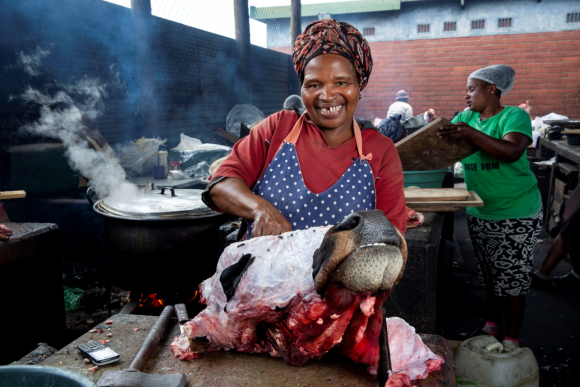
maGagayi carves a bovine head, which typically makes six servings of this popular meal.
At the bovine head market, the air is thick with the ringing of meat cleavers, with wood smoke — and with frustration.
The narrow brick and metal structure where women prepare and sell a traditional meal — meat from the cow’s face served with steamed bread — was supposed to be temporary. Yet Ntombikayise Gagayi (known as maGagayi) and her colleagues have already spent two years in this congested facility.
For over a hundred years, trade has flourished at this major transport hub in the heart of the eThekwini Metropolitan Municipality in Durban, South Africa.
Traditionally, bovine-head cooking was steeped in ceremony and practised only by men in villages. But during the 20th century, when men migrated to the cities to build South Africa’s modern urban infrastructure, women followed. Many set up bovine-head businesses, offering a protein-rich, affordable, and much-loved meal to labourers — and turning ceremony into a lucrative commercial pursuit.
maGagayi is one of the longest-serving bovine head cooks in Warwick. She switched to this work more than 20 years ago, after competition from modern supermarkets killed her sales of other meat and fish.
She’s become an outspoken leader here. Patrick Ndlovu, of Asiye eTafuleni (AeT), recalls that maGagayi recently told off a politician. She accused him of only coming around to get votes before giving him an earful about the long wait for a suitable new facility.
“We are very discouraged and unhappy,” maGagayi says through an interpreter. She glances toward the concrete pillars that jut up into empty air next door. The new facility, she says, was supposed to open nine months ago.
But there are only those concrete supports and a stalled project, waiting for a new contractor to resuscitate it.
The cooks have good reason to be frustrated. After the city announced it would build a new bovine-head market to replace an older facility, these women gave considerable time and energy to consulting on the design, as AeT’s Rebecca Plumbley explains in this blog.
Ntombikayise Gagayi (known as maGagayi) and her colleagues have already spent two years in this congested facility.
They were anticipating an improvement in their working conditions. Instead, they’re stuck in limbo, in a temporary facility that is grossly inadequate — and costing them sales. The space is cramped and awkward to navigate. Customers can enter through only one narrow door and it’s not always easy to get to the particular vendor who makes the meal just the way the customer prefers. The result: fewer customers.
Currently, 22 cooks struggle with this bad set-up — a steep reduction in the market’s workforce. Tellingly, maGagayi says, almost one third have taken leave until the new structure is ready.
Ventilation is another issue. Wood smoke from the cooking fires fills the air before escaping out the openings in the walls, making for an unhealthy atmosphere.
The municipality hadn’t figured the smoke into this design. Rather, they intended for the cooks to switch to propane-fired cooking. But customers complained: without the smoke, the meat didn’t taste as good. So the cooks went back to the traditional method for making this traditional meal.
That sort of uninformed decision-making on the part of officials points to a lack of consultation with the experts: the workers themselves. It runs counter to the principle of inclusive design that AeT has been striving to instill for a decade.
Urban Intelligence
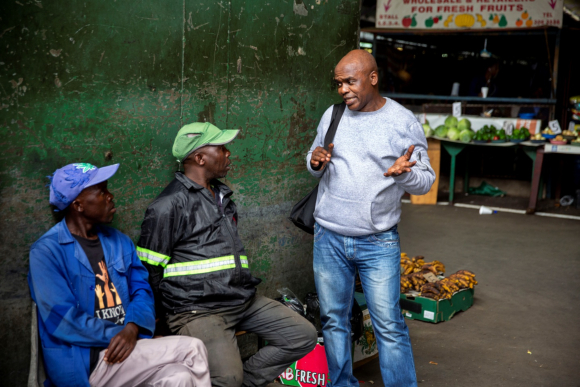
Patrick Ndlovu (standing) talks with two barrow operators at the Early Morning Market, where 676 stalls each provide income for 2-3 traders as well as for the porters who operate barrows in the market.
Walking through Warwick with Patrick Ndlovu, it seems possible that he knows just about every one of the thousands of people who earn their living in what he calls “the world’s biggest mall”. He’s been a fixture here for three decades, so it’s not surprising that they know him, too. What is surprising is how the relationship has changed.
Patrick first began interacting with Warwick’s traders when he was a Metro police officer. His job back then was to enforce the law against informal trade. “I was always nice,” he laughs. “I would arrest you with a smile.”
AeT also facilitates … appreciation of the market’s vital economic, social and cultural significance through Markets of Warwick Tours.
Later, as an area manager for the eThekwini municipality, he became more of a facilitator, providing administrative help and assistance to resolve disputes. Increasingly, however, he felt there had to be a better way of serving this large workforce. In 2008, he and architect Richard Dobson founded AeT, an NGO that emphasizes smart urban planning in close consultation with informal workers.
On the edge of Warwick’s Early Morning Market, Patrick points to a wooden cart that was used to transport goods from storage to stall and now sits roadside, unattended. Local authorities want to impose a by-law against “abandoned goods”. But Patrick explains that to take this cart back to a storage facility would require abandoning the goods at the stall. For traders, it sets up a no-win situation.
“This is why we always talk about urban intelligence,” he says.
AeT also facilitates advocacy and education, and strives to help outsiders appreciate this unique market and its vital economic, social and cultural significance through Markets of Warwick Tours.
Good Fortune and Looming Threat
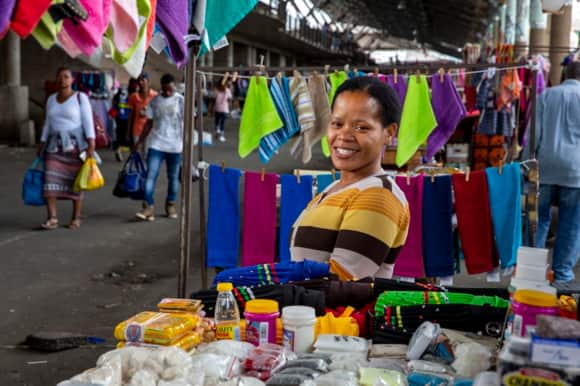
Tina Mteshane, a Warwick tour guide, has a “lucky” stall in Brook Street Market.
Tina Mteshane is one of the traders trained by AeT to give narrated tours of the iconic market. Tour clients can range from local media to tourists from far-off Asian and European countries.
The petite, affable young mother with the fast smile enjoys showing people around the area where she has worked for a decade, even if the opportunity only presents itself about once a month because, she says, so many guides have now been trained.
Markets at Warwick experience the perennial threat of new developments.
The rest of the time, she sells clothing and personal items in the bright, busy Brook Street market, where she enjoys an excellent spot. “Business is good,” she says. “I am very lucky.”
Her good fortune, however, feels precarious.
Markets at Warwick experience the perennial threat of new developments. Between 2009-2011, the workers who have long made their living in the Early Morning Market undertook a legal battle to stop the building of a private mall. Their determined advocacy won that battle. Now Brook Street and neighbouring markets are under a looming shadow as plans to build a massive, modern shopping mall over top the rail station threatens to displace the informal traders.
Tina worries about her colleagues — especially the older ones — if they lose this livelihood option. Formal businesses, she notes, aren’t interested in hiring anyone who is older than 35. “Most of the people here are older,” she says. “How will they survive?”
Second-hand Clothes and Declining Sales
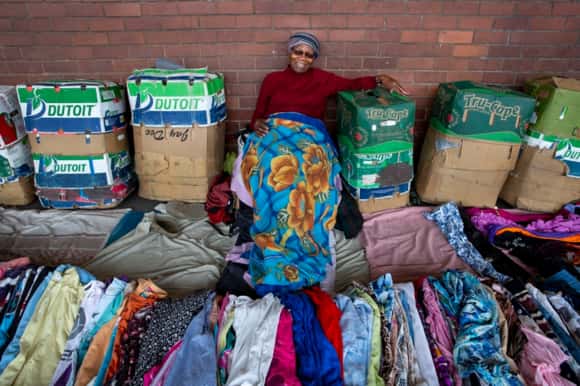
Mabel Ntuli has sold second-hand clothing in Warwick for decades — but the declining market is a concern.
While the looming threat of relocation to make way for formal retail is a worry, there are other, more immediate threats to livelihoods in Warwick.
Mabel Ntuli sits on a soft stool, back to a brick wall, and watches as the market moves around her. But it doesn’t move as briskly now as it once did, and sales aren’t as brisk, either.
On a bad day .. second-hand clothing sellers don’t see even a cent.
In front of her, she displays her wares artfully in a wide arc: second-hand clothes, cleverly folded and interleaved to entice. She buys these clothes from a range of church, charity and jumble sales. Occasionally, friends and acquaintances will call to say come, we have clothes.
The 82-year-old woman has been selling clothes in this market since her cousin introduced her to the business in 1982. Back then, employment in South Africa was higher, she recalls, so people had money to spend. If trading was brisker, it was also riskier because it was illegal; the traders had to contend with police who would chase them away. Nonetheless, the earnings from selling second-hand clothes were enough for women to educate their children.
Mabel raised three of her sister’s children, as well as her own daughter. Once educated, however, that generation faced a shortage of jobs. Now many of them, including Mabel’s daughter Ntombifuthi, work here. Ntombifuthi previously held a job in a factory, but competition from imports caused the factory to close.
Mabel says competition from foreigners who import bales of second-hand clothing is also a problem for her business.
These economic forces have combined to slash her earnings. In the past, Mabel says she could make R400 a day; now on a good day, she might earn R200. On a bad day, she concedes, second-hand sellers don’t see even a cent.
Plus, now that their enterprise is legal, they must buy permits to trade in this area, and that amounts to a high rent set against their low income.
Still, Mabel has no intention of giving up the business. She prefers coming to work to sitting idly at home, she says, and wants to remain part of the vibrant community that has sustained her for so long.
Traders as Crime Fighters
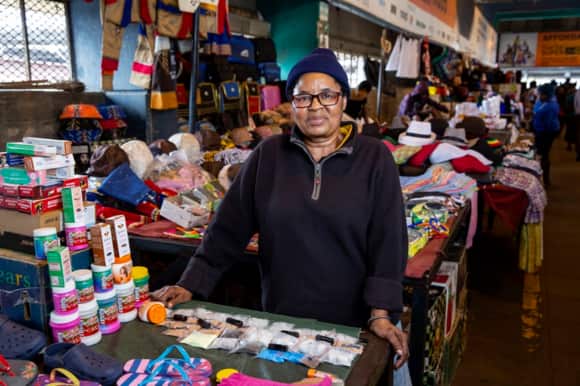
A steady stream of passengers transits the long corridor of the Berea Train Station. As they pass through, people on the move can purchase a wide array of necessities and niceties—from food to toiletries, giftware and clothing—from the many informal traders who earn a living here.
But as local trader Beauty Mgiqizane can attest, where there’s money to be made, there’s also crime to be had. And in the volatile 1980s and ’90s, crime was at its peak here. Beauty recalls that, back then, it was not unusual for someone to hold a vendor at gunpoint and strip them of all their goods — disappearing long before police arrived on the scene. But after a violent robbery led to the stabbing of a police officer about three decades ago, the station’s traders knew they had to act. They came together and formed a TAC — Traders Against Crime — unit to protect themselves and the public.
She continues to serve as part of a group of people who have made it their business to make this section of the market more secure.
Beauty, then in her late twenties and just three years in as a trader here, volunteered for duty. Thirty years later, she continues to serve as part of a group of people who have made it their business to make this section of the market more secure.
It’s a community effort that has engaged the police not as adversaries but as partners in crime prevention. The South African Police Services offers TAC volunteers training on how to respond safely when threats occur and keep the peace while they contact police.
Now, Beauty says, there’s less crime, and while there are other factors, she believes the constant presence of vigilant, well-trained informal traders has served as a significant deterrent.
Perseverance in the Face of Hardship
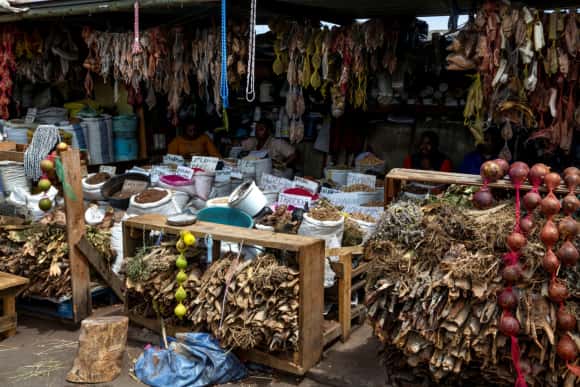
In July of 2018, Warwick’s traditional herb and medicine market nearly went up in smoke. Fire swept through the rooftop market on a weekend night. While no one was hurt, the devastation was immense. Some traders lost everything — not just stock, but the savings they had stashed in their stalls because they go home at night to unsafe areas.
After the fire was out — nothing. The municipality’s non-response added insult to injury. A month later, as Rebecca Plumbley wrote, the rainy season threatened and no emergency shelter had been provided. It was the traders themselves who pooled what little they had and took out loans to rebuild tables and overhangs. Now many are struggling with debt.
But the traders who specialize in this traditional enterprise are no strangers to hardship.
But the traders who specialize in this traditional enterprise are no strangers to hardship. During the apartheid years, traditional medicine was suppressed and had to go underground. Its purveyors fought to keep alive the practice, which has both cultural and dietary significance. When this market moved to its current location in 1996, organizing began in earnest. A large association of traditional healers became a national force, and ultimately won a Parliamentary Act that recognizes traditional medicine.
They persevered then, and they have persevered after the fire.
Richard Dobson, co-founder of AeT, says that those who were most affected got help from their colleagues, who lent them stock so they’d have goods on their tables to sell.
“This is what’s so exciting about the informal economy,” he says. “There’s enormous solidarity.”
That solidarity, backed by the resilience and determination of the individuals who make these markets so vibrant, may prove to be the best weapon against the forces that threaten Warwick Junction.
With thanks to AeT’s Patrick Ndlovu, Richard Dobson, Phumelele Mkhize and Rebecca Plumbley, all of whom provided a wealth of information, interpretation, time and guidance to this project.
.jpg)